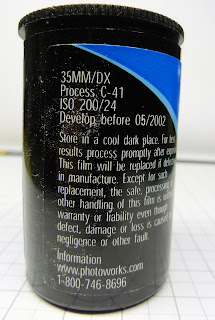Last year, I picked up a few odd rolls of long-expired color film, and most of it was labeled Seattle Film Works with expiration dates from 2000 to 2002. At one time, Seattle Film Works (SFW) was known for their line of SFW-XL films that were actually Kodak and Agfa cine film with a remjet backing -- and SFW was the only place that would process that film. I wrote briefly about Seattle Film Works in a previous blog post on ECN-2 process films. Until the 1990s, SFW films were all ECN-2 stock, but in the mid-late 1990s, the company started switching to C-41 film stocks and did not change the process used on the film canister. By the year 2000, SFW had morphed into PhotoWorks, with a change in the canister colors and design -- and indicated that the film was C-41. The other change was going from 20 exposure to 24 exposure rolls. Typically, when you sent your "SFW-XL" film to SFW, you received a "free" roll back with your set of prints. In the late 1990s, I used a fair amount of the SFW film and received prints, negatives and slides + the roll of film with every order. In 2000, a lawsuit claimed that SFW engaged in deceptive practices by claiming the film, now C-41, could only be processed by SFW. That lawsuit ended with PhotoWorks having to send out thousands of free rolls of the C-41 film to customers. By 2011, PhotoWorks was gone, its customer list sold to Shutterfly.
The roll of PhotoWorks 200 was manufactured it Italy - hence it's Ferrania (Solaris) 200 film, and its expiration date was 05/2002. That puts the film as being made around 2000. Given its age, I figured that I would rate it at ISO 64. I loaded the roll into my Ricoh ZF which I reviewed previously in my post on the Tucson Police Dept. camera. After I finished the roll, I developed it in the FPP C-41 kit. Some of the images are presented below. Overall, I was pretty happy with the results, and the 64 ISO rating was really on target.
One of the unknowns with any long-expired film is how the film was stored for the past 20 years. More than likely, the film was in a camera bag in a closet, which at least means a relatively stable thermal environment. My experience with expired color films is that to never expect perfect results, and the higher the ISO, the less sensitive the film is over time, as dyes oxidize. Without making a 1 stop loss/decade for adjusting the ISO, you'll definitely end up with poor results. If this was the 400 ISO SFW, I'd probably shoot it at ISO 80.
For expired E-6 (slide) films, it's even more critical to test a roll, if possible, before shooting anything serious. If the film was stored in a freezer or fridge for most of its life, then low ISO films such as Fujifilm Velvia 50 can often be shot at box speed, or at ISO 32-40. Ektachrome 400 should be rated at least at 200 -- if it was cold stored. Again, part of the fun with long-expired films is to see what you'll get - but don't use them for once-in-a-lifetime shots. With the access to color film seemingly restricted at this time, expired films are selling for a lot more. Don't overpay!









1 comment:
Back in 1999, I ordered a couple rolls of that film - a 200 and 400 ASA roll. I shot the 400 in 1999 and it turned out normal. About 5 years ago, I found the 200 roll in a box stored in my hot upstairs. I don't have great expectations about how it will turn out, I know it won't look as good as your examples, but I'll use it someday anyway, just to see.
Post a Comment